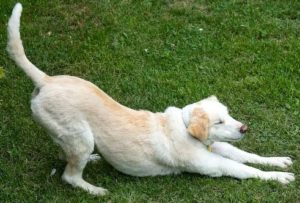Pandiculation, Progressive Muscle Relaxation, and Guided Savasana:
Besides being a new word you can impress your friends with, pandiculation is good for you! It’s like nature’s reset button to relax your muscles and reboot your brain. I imagine you have seen a cat or a dog jump off the couch and do what looks like a full body yawn. It’s a simple move that we humans and nearly all animals have been doing since the beginning of time. It results in more relaxed muscles while having greater muscle control and coordination.
There are three steps to pandiculation:
1. a voluntary contraction
2. a slow lengthening
3. complete relaxation
So what does this do? It resets the length of your muscles, not just in the muscle fibers but also at the level of your brain. It’s different from stretching because it is active, not passive. Lengthening a contracted muscle sends a message to your sensory motor cortex to release accumulated tension. This helps you with proprioception (feeling and sensing your body) and gives you access to fuller range of motion.
Active vs. Passive Stretching:
When you stretch a muscle passively the sensory organs in the tissue send a signal to the brain that the fibers are being stretched. Once you get to your end range the message registers in the brain as dangerous. It says, “STOP! HOLD ON! CONTRACT!”
In an active stretch the muscle is contracted as it is lengthening. This overrides the STOP message and replaces it with a message that tells the nervous system, “it’s okay, I am in control.”
When you are in control you are communicating with your brain which enables a change in the nervous system. It’s this type of change that makes a lasting difference. And it is the very reason I teach you to engage your muscles when you stretch them in my yoga classes.
Learning to relax your muscles is an important skill. The more you practice relaxing the more aware you are of when and where you are holding tension in your body. Over time you will notice the stress response immediately and will be able to relax before the tension can accumulate. And you will have more control over all of your muscles.
Yawning:
Yawning is a type of pandiculation. It is an indication that you are bored, hungry, or fatigued. The act of yawning engages many of your body parts. Your mouth opens wide and your jaw drops so you can inhale as much air as possible. Your lungs fill, your abdominal muscles flex, and your diaphragm is pushed down.
Interesting facts about yawning:
1. yawning gives you energy and makes you more alert.
2. yawning is triggered by a rise in brain temperature and actually cools the brain.
3. yawning circulates cerebral spinal fluid and flushes out sleep-inducing molecules.
4. yawns are contagious! When a friend or relative mirrors your yawn or vice versa it is a sign of empathy.
Practice:
You can do pandiculation and progressive relaxation anywhere, laying on the floor, the couch, or your bed, or even sitting in a chair or even standing. For this practice I will have you lying on the floor. Follow the instructions below or listen along with THIS VIDEO I have created for you.
Step One: Pandiculation
Lay on the floor and do a few rounds of breath. Inhale through your nostrils and fill your belly. Exhale out of your mouth and let yourself let go.
Once you are present join your legs together and your arms over head. As you inhale tense everything like you are squeezing your body into a tube. Then slowly lengthen everything away from center as if you were an arrow. Exhale, drop and completely relax. Repeat this whole body pandiculation three times.
Step Two: Progressive Relaxation
One limb or body part at a time tense the muscles for 5-10 seconds. Then slowly lengthen and stretch them out. Finally completely drop them and relax. Repeat on the next limb or body part until you move through your whole body.
When you have completed your entire body take a moment to scan with your awareness. Repeat any part that does not completely let go.
Step Three: Savasana:
Allow yourself to continue to lay still and relax for 5-20 minutes. You can use a guided Savasana audio or a visualization if you prefer.
To complete, deepen your breath, begin to move in familiar ways, and slowly return to a seated position. You will either be ready for a good night’s sleep, or drink a glass of water and carry on with your day!
Tune in next week for one more way to break up with stress.

Leave a Reply